Femtotechnology: AB-Needles. Fantastic properties and Applications
by A.A. Bolonkin
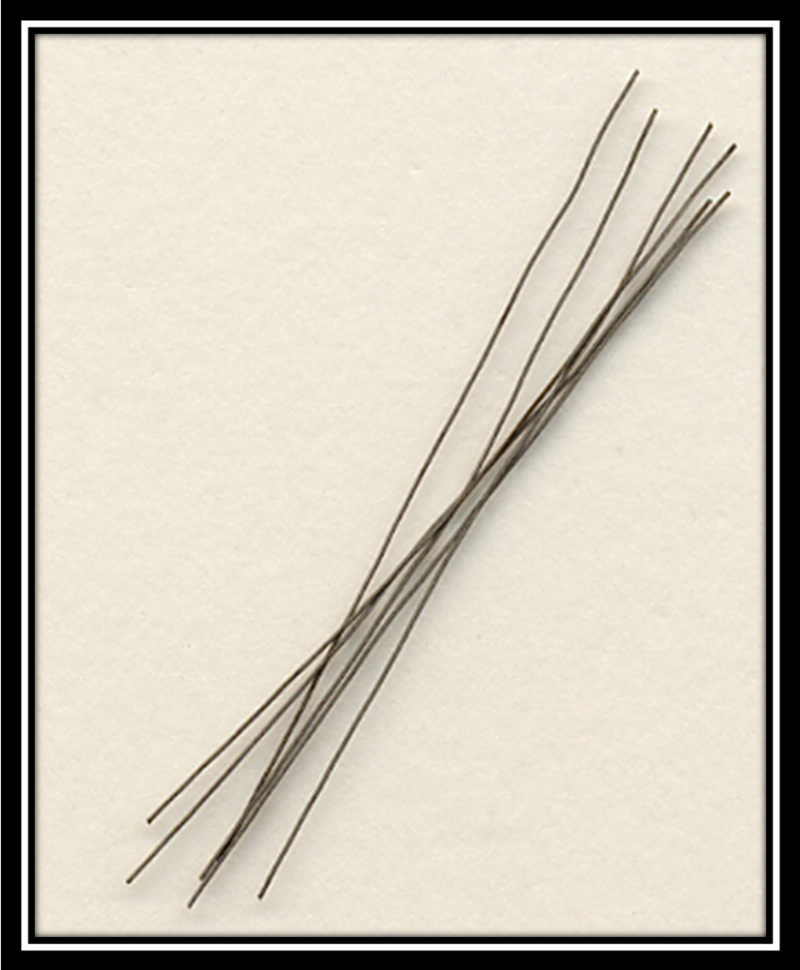
Scribd, December 2010
Femtotechnology: AB-Needles. Fantastic properties and Applications
A.A. Bolonkin
C&R, 1310 Avenue R, #6-F,
Brooklyn NY, 11229, USA
abolonkin@juno.com
In the article "Femtotechnology: Nuclear AB-Matter with Fantastic Properties" [1] American Journal of
Engineering and Applied Sciences. 2 (2), 2009, p.501-514. (http://www.scribd.com/doc/24045154), (http://www.scipub.org/fulltext/ajeas/ajeas22501-514.pdf), author offered and considered possible super strong nuclear matter. But many readers asked about the long-term stability of the proposed nuclear matter. It is well known, the conventional nuclear matter having more than 92 protons or more than 238 nucleons become instable. In the given work the author shows that the special artificial forms of nuclear AB-Matter make it stable and give it fantastic properties. For example, by the offered AB-Needle (in this article) you can pierce any body without any damage, support motionless satellites, reach the other planets, research Earth's interior. These forms of nuclear matter are not in Nature now, but nanotubes also are not in Nature. That is artificial matter buildable in the projected near future by human effort. AB-Matter also is not currently in existence, but research and investigation of their possibilities, stability and properties are necessary for creating them.
Key words: Femtotechnology, FemtoTech, AB-Matter , AB-Needle, applications AB-Matter , stability AB-Matter .
1. Brief history. On December 29, 1959 the physicist Richard Feynman offered his idea to design artificial matter from atoms and molecules at an American Physical Society meeting at Caltech. If he were not already a widely well-known famous physicist, the audience would have laughed at him and driven him away from the podium. All the scientists accepted his proposal as an entertaining story. How can you see the molecule? How can you catch the molecule? How can you connect it to other? How many millions of years you will create one milligram of matter? And thousands of similar questions not presently having answers may be asked. Any schoolboy of that time could have seen that the Feynman proposal was a full fantasy, which had no relation to the real technology of this day.
About 40 years the scientists had not see a way for implementation of this idea. But only in the last 15 years we have initial progress in nanotechnology. On the other hand progress is becoming swifter as more and better tools become common and as the technical community grows.
On 14 February 2009 the author offered the idea design of new matter from protons, neutrons and electrons made initial research and published the article about it [1]. These particles are a million times are smaller than molecules.
Some readers, who did not read carefully the author's article and who remember from school courses that the nucleus becomes unstable if the number of protons are more than 92 or number of nucleons are more than 238, raised the cry that the AB-Matter is impossible. They did not see the main DIFFERENCE between conventional matter (conventional nuclei) and AB-Matter . The conventional matter has a nucleus which has a chaotic spherical LUMP (nucleus) of nucleons, the AB-Matter is a LINE from nucleons NOT having a nucleus.
The author considers below this AB-line and shows that such a line IS STABLE and has a surprising property: one is a high rigid rod (Needle), whose compressed force DOES NOT depend upon rod length! With such AB-rods (Needles) one could theoretically support Earth satellites, reach the other planets, penetrate into the Earth interior and into any molecules of a man without damage to his body.
2. Short information about offered matter. In [1], figs.5, 6 it is shown the AB-Matter may have forms (Fig.1).
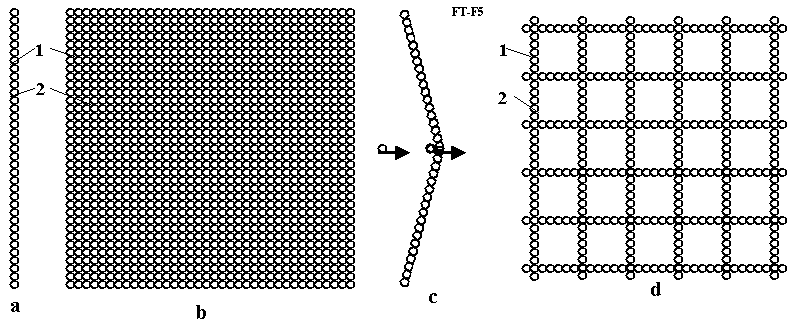
3. AB-Matter . In conventional matter made of atoms and molecules the nucleons (protons, neutrons) are located in the nucleus, but the electrons rotate in orbits around nucleus at millions of times more distance than the diameter of the nucleus. Therefore, in essence, what we think of as solid matter contains a -- relatively! --`gigantic' vacuum (free space) where the matter (nuclei) occupies but a very small part of the available space. Despite this unearthly emptiness, when you compress this (normal, non-degenerate) matter the electrons located in their orbits repel atom from atom and resist any great increase of the matter's density. Thus it feels solid to the touch.
The form of matter containing and subsuming all the atom's particles into the nucleus is named degenerate matter. Degenerate matter found in white dwarfs, neutron stars and black holes. Conventionally this matter in such large astronomical objects has a high temperature (as independent particles!) and a high gravity adding a forcing, confining pressure in a very massive celestial objects. In nature, degenerate matter exists stably (as a big lump) to our knowledge only in large astronomical masses (include their surface where gravitation pressure is zero) and into big nuclei of conventional matter.
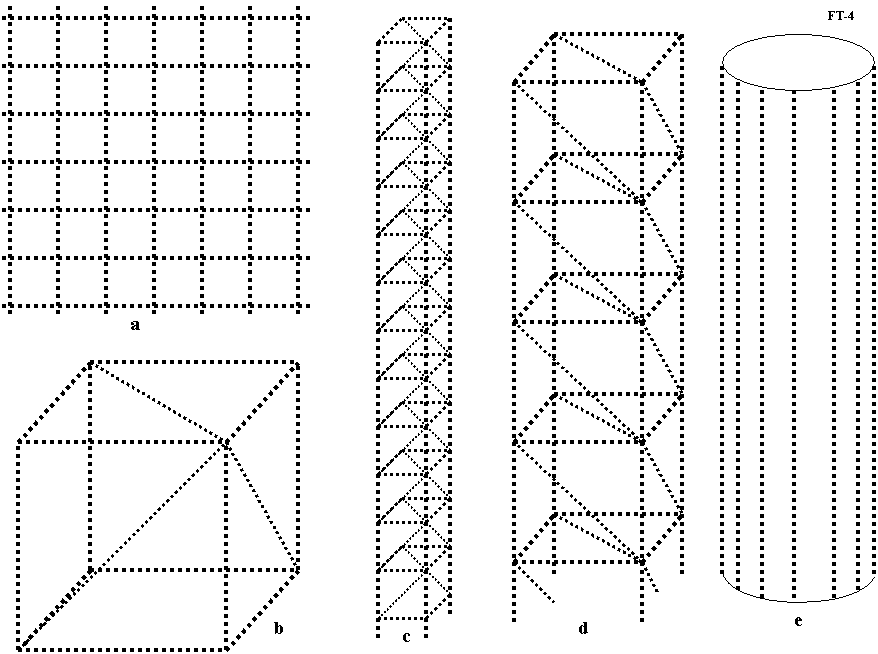
Our purpose is to design artificial small masses of synthetic degenerate matter in form of an extremely thin strong thread (fiber, filament, string, Needle), round bar (rod), tube, net (dense or non dense weave and mesh size) which can exist at Earth-normal temperatures and pressures. Note that such stabilized special form matter in small amounts does not exist in Nature as far as we know. Therefore author has named this matter AB-Matter . Just as people now design by the thousands variants of artificial materials (for example, plastics) from usual matter, we soon (historically speaking) shall create many artificial, designer materials by nanotechnology (for example, nanotubes: SWNTs (amchair, zigzag, ahiral), MWNTs (fullorite, torus, nanobut), nanoribbon (plate), grapheme, buckyballs (ball), fullerene). Sooner or later we may anticipate development of femtotechnology and create such AB-Matter. Some possible forms of AB-Matter are shown in fig.3.
The main difference the AB-Matter from conventional matter is a strict order of location of the proton and neutrons (for example: proton-neutron-proton-neutron-.... ) in line (string) or in the super thin (in one nucleon) plate (nuclear graphene). That gives a strong tensile stress (electrostatic repulsive force), which does not allow the nucleons to mix in a messy clump (ball). This force is less than the nuclear force if the AB-Matter has a form where the most protons are located far from one other, where the nuclear force from the far protons is absent. That applies in the forms of line, net and plate (fig.1a,b,d), but that may be absent in the solid beam, rod (fig. 3c,d) if their cross-section area contains a lot of nucleons.
Sidestepping another possible problem: AB matter will capture electrons to compensate for their own positive charge. Or, in cases where this is insufficient bombardment with e-beams may be employed to stabilize it. Compensation of the positive charges is solved by rotation of electrons around the AB string, rod, tube, net (grid) or an electron cloud near the plate [1] or the electrons located near nucleons.
Another way is using a construct of AB-Matter as a continuous film or net (fig. 2b,d) or as the AB-Needles (fig.2).
The AB-Matter film and net may be used for energy storage that can store up huge energy intensities and used also as rocket engines with gigantic impulse or weapon or absolute armor (see computation and application sections in [1]). Note that in the case of absolute armor, safeguards must be in place against buffering sudden accelerations; g-force shocks can kill even though nothing penetrates the armor!
2. Law of Stability of Nuclear AB-Matter
Conventional matter consists of atoms and molecules. Molecules are collection of atoms. The atom contains a nucleus with proton(s) and usually neutrons (except for Hydrogen-1) and electrons revolve around this nucleus. Every particle may be characterized by parameters as mass, charge, spin, electric dipole, magnetic moment, etc. There are four forces active between particles: strong interaction, weak interaction, electromagnetic charge (Coulomb) force and gravitational force. The nuclear force dominates at distances up to 2 fm (femto, 1 fm = 10-15 m). They are hundreds of times more powerful than the charge (Coulomb) force and million-millions of times more than gravitational force. Charge (Coulomb) force is effective at distances over 2 fm. Gravitational force is significant near and into big masses (astronomical objects such as planets, stars, white dwarfs, neutron stars and black holes). Strong force is so overwhelmingly powerful that it forces together the positively charged protons, which would repel one from the other and fly apart without it. The strong force is key to the relationship between protons, neutrons and electrons. They can keep electrons into or near nuclei. Scientists conventionally take into attention only of the strong force when they consider the nuclear and near nuclear size range, for the other forces on that scale are negligible by comparison for most purposes.
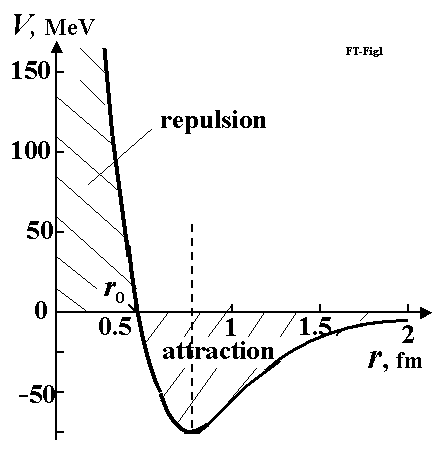
Fig.4. Typical nuclear force of nucleus. When nucleon is at distance of less than 1.8 fm, it is attracted to nucleus. When nucleon is very close, it is repulsived from nucleus.
(Reference from http://www.physicum.narod.ru , Vol. 5 p. 670).
The necessary condition (prerequisite LAW) of stability the AB-Matter are the following:
1) The number of protons must be less approximately 90 into a local sphere of radius 3 fm at any point within AB-Matter.
2) The number of nucleons must be less approximately 240 into a local sphere of radius 3 fm ( 6 fm diameter) at any point within AB-Matter .
3 AB-Matter contains a minimum of two protons.
That law follows from relation between attractive nuclear and repulsive electrostatic forces into nucleus. The nuclear force is short distance force (2 fm), the electrostatic force is long distance. When number of protons is more than 92, the repulsive electrostatic force may become the more than nuclear force and electrostatic force may destroy the AB-Matter.
Consequence. That law means: the number of nucleons at any point of a cross-sectional area AB-Matter design of fig.3 must be less than 37 within a radius of 3 femtometers. This does not limit the strong pressure possibilities of AB-Matter because AB-Needles have the surprising property discovered by author - the ability to transmit a huge pressure force without ordinary buckling occurring in any length of AB-Needle (transferring a input pressure to any long distance). That property is described in next paragraph.
The most important design of AB-Matter is connection of nucleons in string (fig.5a,b,c). That may be only protons pppp.... (fig.5a), proton-neutron-proton-neutron-.... (pnpn....)(fig.5b), proton-neutron-neutron-proton-neutron-neutron-.... (pnnpnn.... )(fig.5c). The ends of AB-string contains the protons. The electrostatic repulsive force of these end protons is not BALANCED and create the strong repulsive force 3 (fig.5c,d,e) which stretches the AB-string. That helps to keep the string form and other form (plate, tube, beam, shaft, rod, etc.) of AB-Matter presented in figs. 3, 5.
That is a very important property. This property is absent in conventional molecular matter, because conventional matter contains neutral molecules. The charges of ions in conventional matter are locate far one from other and the net repulsive force is small. The property discovered by the author gives the AB-String the amusing feature: Independence of the safe pressing stress from the LENGTH of the nuclear string. Reminder: The safety pressing force of long conventional matter strong depends upon length of wire, beam, shaft, etc. According to Euler's Law the safe compressive force in ordinary matter is inversely proportional to the square of the length of the rod. If the length of rod is more than the safe length, the construction loses stability (buckling or bending). You cannot, for example, with ordinary matter, push a car with a thread or thin wire having one km length. Such thin long rod like structures will buckle and bend.
By contrast, the AB-Matter thin string can pass a given compressive force for any length of string. That why it is named the AB-Needle. AB-Needle allows penetrating into any conventional matter, into the interior of Earth, planets, Sun. They allow making interplanetary trips and investigations of planet from Earth. (Given the necessity of compensating for local and target planetary rotation!)

Fig.5. Connection of nucleons in string (Needle) (fig.2a,b,c) and film, plate (fig.5d,e) and Coulomb (electrostatic, repulsive) force. Notations: 1- protons, 2 - neutrons, 3 - repulsive (Coulomb) force from protons.
Let us estimate the forces into AB-Needle.
1) Nuclear attractive force. The radius of proton is r = 0.877 fm (10-15 m). The connection energy of proton and neutron pn (2H or 2D) is about E = 1 MeV = 1.6в10-13 J; the connection energy of pnn (3H or 3He) is 3 MeV; the energy of pnpn (4He) is 4 MeV. Let us take the average connection energy 2 MeV. The distance (where the nuclear force is actives) is about l = 1 fm. Consequently the average attractive nuclear force is
. (1)
That is a huge value because the cross-section area of AB-Needle is millions of times less than the diameter of the simplest molecules of hydrogen. Note: this force appears only when the outer force wants to break the AB-Needle. If no outer tensile force exists, the internal strong nuclear force (summary of forces intothe nucleus) equals zero.
, (2)
where k = 9"109 . Substitute an electric charge e = 1.6. 10-19 C and 2r = d = 1.754 fm . We receive F1p = 74.8 N.
The electric repulsive force decreases with distance d = 2r between protons. If we summarize the repulsive force from all protons in line pppp.... of AB-Needle (fig.5, marked 1), we receive
Fp = 1.64 F1p - 123 N. (3)
That means the AB-Needle has gigantic internal stress, which extends the AB-Needle. (Keeps it taut.) That extended stress is less than the attractive maximum nuclear force and one does NOT depends upon the length of AB-Needle. This extended stress decreases the maximal outer stretching force but one allows keeping the AB-Needle taut while compression force is less than the extending force. If the pressing force is more than the extending force the AB- Needle bends into an arc but continues to transmit the maximal safe pressing force.
In case pnnpnn... (fig. 5, mark 3) the force Fp (3) decreases in nine times (32 = 9) and equals Fp - 14 N.
This tensile stress is transmitted through the protons to other end of AB-Needle. That means the large pressure on the ends of AB-Needle is passing along thin AB-Needle through electrostatic repulsive force and one does not depend upon the length of the AB-Needle.
That may be illustrated by a children long inflatable air-balloon (fig.7a). This pressing force also does not depend upon the length of balloon. The force is transferred by compressed air. This idea was used by author in the design for an inflatable space tower [Bolonkin A.A., Non-Rocket Space Launch and Flight, Elsevier, 2005, Ch. 4].
The tension Fp is active along the entire length of AB-Needle and does not allow curling the AB-String into the form of a tangled conventional nucleus. This tension works when no other closed protons with a side of the string. When an AB-Needle is created, the outside protons cannot join (stick to) the AB-Needle because the protons repel each other.
The proton and neutron have magnetic dipole moments. Magnetic dipole moment of proton equals +1.41"10-26 J/T, of neutron equals -0.966 "10-26 J/T. They are small magnets having magnetic force of some newtons. That also allows creating the stable AB-Needles, to arrange them in a certain position and order.
The AB-Needle can also keep the maximal side force F2 - 0.5F1 (fig.7b). That allows accelerating anybody or anything (for example space ship) in a side direction, to produce an elastic design (for example, air bridge, storage of mechanical energy, long arm (AB-Hand), etc.). AB-Matter designs do not have such tiresome drawbacks of ordinary matter as fatigue, residual strain and susceptibility to the external environment (weathering, etc.)
One meter of AB-Needle is a line having n = 5.7.1014 nucleons with mass m = 1.67. 10-27 kg. Total mass of one meter AB-Needle equals only 10-12 kg/m.
M1 = nm = 5.7.1014 в1.67. 10-27 = 10-12 kg/m.
One million kilometers of AB-Needle weighs only 10-3 kg/Mm. For transfer of a large force we can make a thin cable from many AB-Needles.
4. Application of AB-Needles.
Some properties of AB-Matter are considered in [1] and here. It has a gigantic strength. The maximal tensile stress equals ?t - 8"1031 N/m2 (nanotubes have only ?t - 2"1011 N/m2, that is 100 billion billion times less), high maximal pressure stress of the long stability AB-Needle equals about ?t - 7.5"1030 N/m2, the safe operating temperature is millions of degrees. (It might thus penetrate the outer layers of the Sun--from Earth!)
In our consideration you must remember that nuclear AB-Needle is over a million times less diameter than the simplest hydrogen molecule. Our AB-Needles may be contrasted with a (hypothetical and impossible) conventional rod sticking long through the Solar system. The probability to meet any given planet, asteroid or meteor in space is very small. A practical example is space junk: Tens of thousands of these small artificial remnants are orbiting around Earth. To actually contact them would be catastrophe for a satellite or space ship or station. But actual collisions are surpassingly rare. Even when an AB-Needle contacts the conventional matter of a planet or the Sun, swirling in this sea of molecular space the AB-Needle can meet only very rarely any nucleus. But they are also charged positively as the AB-Needle itself and they will move away by electric force from the AB-Needle. So rather like a very long teaspoon, they can stir around between the particles of conventional matter but will not break off by collision.
1. Penetration into human body. We can penetrate into the human body by AB-Needle (cable from Ab-Needles) without bodily damage. We reach any cells of the human body, however inaccessible, however presently inoperable, without bleeding. We can design an artificial arm (AB-Hand) (fig.7f) of a arbitrary length, connect to the end of this arm the equivalent of a femto TV, femto devices, observe and manipulate within the human body.
We can work from a distance in the hundreds of kilometers. (Remember that the arm above was of arbitrary length, although it might have to be a straight-line distance given the stiffness of the AB-Needle) The man will not see our artificial arm and not feel as AB-Needles penetrate into his body and do their work, for good or ill. We can repair or (disturbing thought) damage his body. Any conventional wall, armor, underground shelter cannot to protect him, except special AB-Matter (AB-Armor).
We can build (work) by AB-Hand projects or constructions or do work located hundreds or thousands of kilometers from objects. (Although it might have to be a straight-line distance given the stiffness of the AB-Needle--but hundred kilometer tall towers would give vast visible horizons of straight operating length).
Estimation of a maximal specific storage energy Ems [N/kg] approximately is
, (3)
where L is length of AB-cable, m; M is mass of AB-cable, kg; Fp is maximal safety repulsive force of cable, N. For cable pnpn... this energy may reach about 1013 J/kg. Cable may contain thousands of AB-Needles. That is about a million times more than the energy in an equivalent weight of the explosive TNT. The density of energy may be also be of very high value up to 1021 J/m3. That a thousand billions of times more than the energy density of a rocket fuel.
Below is a table, which shows the some properties of some protection of AB-Nets.
Table 1. Protection of some AB-Nets (pnpn...) and their properties.
|
|
|
|
|
|
|
|
|
|
|
|
|
|
|
|
|
|
|
|
|
|
|
|
|
|
|
|
|
|
|
|
|
|
|
|
|
|
|
|
|
|
8. AB-Needles and space flight. AB-Needle (cables) open gigantic possibilities in space research and flight.
You can use the AB-Hand manipulator (arm) employing AB-Needles having length of hundreds millions kilometers and with femto device end effectors (fig.7d). If mass of these payload devices is 1 - 10 kg, the mass of AB-Hand must be 1 - 10 grams for 1 million of kilometers. The distance to Moon is 384,400 km, to Mars 78 millions km (when Mars is closest position, every two years). You can study and research these space bodies (including the deep interior) from your home. Moreover, using the powered AB-hand, you can build a base remotely before you will travel to it.
We can lift by AB-Cable payloads into space over a distance of a thousand km or a million km (figs. 6b, 7b), keep levitated motion less satellites, and deliver satellites or entire prefabbed bases to other planets. No problem to build the Space Elevator including GEO (and higher) Space Elevator from Earth surface (fig.7c). No problem with conventional cables for a Space Elevator. Any space garbage, meteorite from conventional matter cannot damage the femto cable because the femto cable penetrates molecular matter.
We can cheaply and quickly fy to space in a manner similar to rocket powered space ships (fig.7d). The small spool of AB-Cable will accelerate and decelerate space ships and facilitate (with special rotation counter-measures) permanent connections from space to Earth. Below the reader will find computation of time, speed and some other parameters of space flights to planets of solar system by offered AB-Cable propelled space ship.
Table2. Computation of space flight to solar planets by AB-Matter space ship.
The acceleration and deceleration have g = 10m/s2, mass of space ship is 3 tons.
|
|
|
|
|
103 sec |
time, Days |
speed, km/s |
AB-Cable kg |
|
|
|
|
|
|
|
|
|
|
|
|
|
|
|
|
|
|
|
|
|
|
|
|
|
|
|
|
|
|
|
|
|
|
|
|
|
|
|
|
|
|
|
|
|
|
|
|
|
|
|
|
|
|
|
|
|
|
|
|
|
|
|
|
|
|
|
|
|
|
|
|
|
|
|
|
|
|
|
|
|
|
|
|
|
|
|
|
|
|

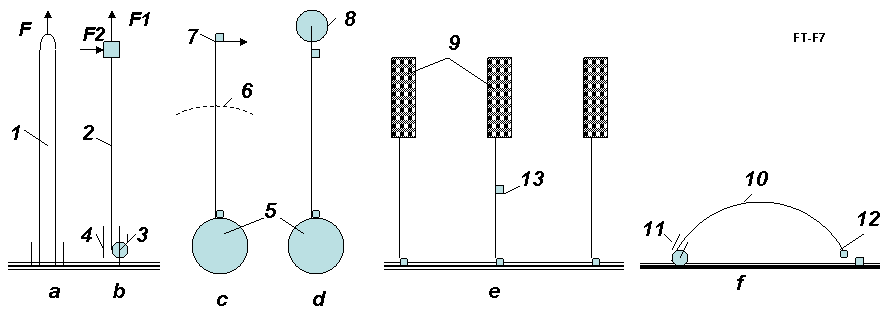
The possible particles are shown in Table 3.
Table 3. Charge, impulse and magnetic moments of some nucleus
|
|
(particles) |
+e=1.6"10Ђ19 C |
number |
moment, ? |
moment, ЅN |
|
|
|
|
|
|
|
|
|
|
|
|
|
|
|
|
|
|
|
|
|
|
|
|
|
|
|
|
|
|
|
|
|
|
|
|
|
|
|
|
|
|
|
|
|
|
|
|
|
opposite the impulse moment.
Notes about possible form AB-Needles. The possible form of AB-Needles are shown in fig. 8.
The first form marked 1 (pppp...) contains only line of protons. This form is cheapest and has maximum pressure strength. But it is unknown, if this form is possible or no. It is known the single hydrogen and single proton is stable. In other side the fusion of two SINGLE hydrogen nuclei 1H (protons) produces deuterium 2H= D (pn) releasing a positron and a neutrino as one proton changes into a neutron:
The positron immediately annihilates with an electron, and their mass energy is carried off by two gamma ray photons:
But most nuclei have a lot of protons and they do not rely upon the reaction (4). The AB-Needle also has a lot of protons. If reaction (4) is released, the form 1 transfers in form 2 (fig. 8) and the process produces a lot of a nuclear energy. The ionized conventional hydrogen 1H may be used for production of AB-Matter . I repeat: the Universe is composed of about 75% hydrogen. In result we will have the AB-Needle in form npnp... .
The second form of AB-Needle is pnpn... marked 2 (fig.8). This form may be produced directly from deuterium D oriented by magnetic field along axis of AB-Needles.
The third form of the double AB-Needles marked 3 (fig. 8) also may be produced directly from deuterium D oriented by magnetic field perpendicular of axis of AB-Needles.
The forth form of four-Needles marked 4 (fig.8) may be produced directly from helium 4He oriented by magnetic field perpendicular of axis of AB-Needles.
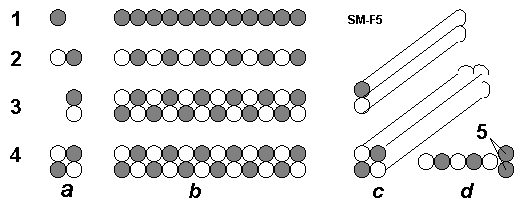
1) Toroid method. One of installation for production of AB-Needles is shown in fig. 9. The installation has a vacuum toroid 1 and particles gun 4 which injects charged particles into toroid. The perpendicular (to fig.) magnetic lines 2 penetrate the toroid. As result the charged particles 3 move in circles inside the toroid. This electric current of particles produces the magnetic field 5 (pinch-affect). This field pulls the particles in a cord and helps to keep them into the toroid ring.
The producing AB-Needles 8 locate inside the toroid ring and are kept by special local magnetic field 9 in position along the circle axis of the toroid ring. That means the moving particles can connect to AB-Needles only to the end nucleus when they collide on the forward end of AB-Needle and their energy is sufficient to overcome the Coulomb repulsion. The toroid ring has the accelerators 6, 11 and focusers 7, 10 of particles. Their electric fields collect the scattered charged particles back to toroid axis.
Probability of hitting in the front end of the AB-Needles is small. But the charged particles rotate into toroid a lot (millions) of times and join to end of AB-Needles. Note they can connect only to the end of the AB-Needle. Their perpendicular speed to the toroid circle axis does not enough for overcame the nuclear repulsion force.
Author wrote only one possible scheme (schematic diagram) of the AB-Needle producing. The developing of this method may request large scale research and work.
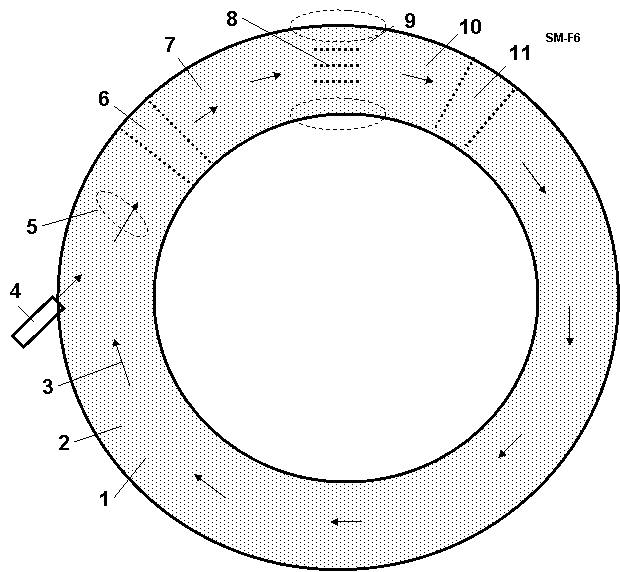
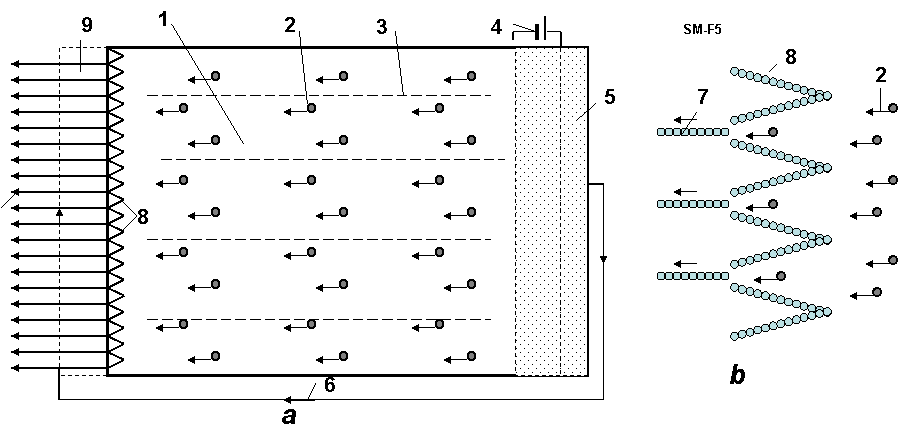
Fig. 10. Method particle traps for production of the AB-Needles. Notations: a - device; b - particle traps; 1 - vacuum cell; 2- charged particles; 3 - magnetic lines; 4 - electric issue for the acceleration nets; 5 - plasma from particles; 6 - flow of electrons; 7 - AB-Needles; 8 - trap made from AB-Matter for the charged particles (p, 2H, 4He, etc.) ; 9 - cell for cover the AB-Needles by electrons.
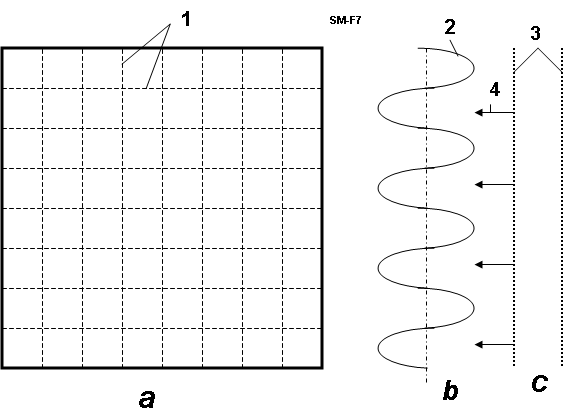
Fig.11. Net of electromagnetic traps for AB-Matter producer. Notations: (a) - forward view; (b) - the monochromatic polarized electromagnetic standing waves (electrostatic part, side view); (c) - particles storage and accelerator; 1 - net from the perpendicular monochromatic polarized electromagnetic standing waves; 2 - the electromagnetic monochromatic polarized standing wave; 3 - electric accelerator of particles; 4 - particles.
The offered AB-production mechanisms can be used for production of the new NANO-tech matter. Now scientists propose to produce nano-matters by nano-robots. I think that is very difficult way. The nano-robot must have working the devices for searching, recognizing, catching the flying molecules, delivering them in a given place, connection to other selected molecules. That means the nano-robot must have a millions molecules. This might be as difficult as making an elephant out of fly size particles and getting it to build itself by catching and sorting these and gluing it to itself. By contrast, the production of AB-Matter may be easy.
Also we can ionize the molecules (create charged particles!) and apply the modified offered methods for design and production of the nano-scale molecular constructs.
Discussion
The Humanity will make a gigantic jump in technology when one will produce AB-Matter . We consider unconventional applications of AB-Matter .
1. Super Micro-World from AB-Matter : An Amusing Thought-Experiment. AB-Matter may have 1015 ¤ 1043 times more particles in a given volume than a single atom. A human being, man made from conventional matter, contains about 5в1026 molecules. That means that `femto-beings' of equal complexity from AB-Matter (having same number of components) could be located in the volume of one microbe having size 10 ? = 10Ђ5 m. It is difficult to make such a nano-robot (one is large for Nano World). But the smart small femto-robot is suitable for Nano World. In future the people could make the artificial intelligent super femto F-beings which can withstand a huge temperature, acceleration of electric field, travel to other stars, other galactic, live in stars and travel through black holes to other Universes and times. To accelerate them to lightspeed would be endurable for them in a single second.
Readers usually ask: The connection between proton to proton gives a new element. After 92 protons, this element is unstable?
1) Any sphere having radius R - 6в10-15m in any point of structure figs. 1 - 4 must contain NOT more 238 nucleons (about 92 of them must be protons). That means any cross-section area of the solid rod, beam and so on of AB-structure (for example figs. 1b,c,g) must contain NOT more than about 36 nucleons in any circle with R - 6в10-15m.
2) AB-Matter must contain the proton in a certain order because the electrostatic repulsive forces of them give the stability of the given structure.
3) The magnetic force of protons allows also gives the different form of AB-matter.
The author offers a design for a new form of nuclear matter from nucleons (neutrons, protons), electrons, and other nuclear particles. He also suggested the necessary conditions of stability of AB-Matter . He shows that the new AB-Matter has most extraordinary properties (for example, (in varying circumstances) remarkable tensile strength, stiffness, hardness, critical temperature, superconductivity, super-transparency, ghostlike ability to pass through matter, zero friction, etc.), which are millions of times better than corresponded properties of conventional molecular matter. He shows (in [2]) how to design aircraft, ships, transportation, thermonuclear reactors, and constructions, and so on from this new nuclear matter. These vehicles will have correspondingly amazing possibilities (invisibility, passing through any walls and amour, protection from nuclear bombs and any radiation, etc).
People may think this fantasy. But fifteen years ago most people and many scientists thought - nanotechnology is fantasy. Now many groups and industrial labs, even startups, spend hundreds of millions of dollars for development of nanotechnological-range products (precise chemistry, patterned atoms, catalysts, metamaterials, etc) and we have nanotubes (a new material which does not exist in Nature!) and other achievements beginning to come out of the pipeline in prospect. Nanotubes are stronger than steel by a hundred times--surely an amazement to a 19th Century observer if he could behold them.
Nanotechnology, in near term prospect, operates with objects (molecules and atoms) having the size in nanometer (10-9 m). The author here outlines perhaps more distant operations with objects (nuclei) having size in the femtometer range, (10-15 m, millions of times less smaller than the nanometer scale). The name of this new technology is femtotechnology.
I want to explain the main thrust of this by analogy. Assume we live some thousands of years ago in a great river valley where there are no stones for building and only poor timber. In nature we notice that there are many types of clay (nuclei of atom--types of element). One man offers to people to make from clay bricks (AB-Matter ) and build from these bricks a fantastic array of desirable structures too complex to make from naturally occuring mounds of mud. The bricks enable by increased precision and strength things impossible before. A new level of human civilization begins.
I call upon scientists and the technical community to research and develop femtotechnology. I think we can reach in this field progress more quickly than in the further prospects of nanotechnology, because we have fewer (only 3) initial components (proton, neutron, electron) and interaction between them is well-known (3 main forces: strong, weak, electrostatic). The different conventional atoms number about 100, most commone molecules are tens thousands and interactions between them are very complex (e.g. Van der Waals force).
It may be however, that nano and femto technology enable each other as well, as tiny bits of AB-Matter would be marvellous tools for nanomechanical systems to wield to obtain effects unimaginable otherwise.
What time horizon might we face in this quest? The physicist Richard Feynman offered his idea to design artificial matter from atoms and molecules at an American Physical Society meeting at Caltech on December 29, 1959. But only in the last 15 years we have initial progress in nanotechnology. On the other hand progress is becoming swifter as more and better tools become common and as the technical community grows.
Now are in the position of trying to progress from the ancient `telega' haywagon of rural Russia (in analogy, conventional matter composites) to a `luxury sport coupe' (advanced tailored nanomaterials). The author suggests we have little to lose and literal worlds to gain by simultaneously researching how to leap from `telega' to `hypersonic space plane'. (Femotech materials and technologies, enabling all the wonders outlined here).
The material related to this topic are presented in [1]-[8].
The author wishes to acknowledge Joseph Friedlander (of Shave Shomron, Israel) for correcting the English and offering useful advices and suggestions.
REFERENCES
(The reader may find some of these articles at the author's web page http://Bolonkin.narod.ru/p65.htm, http://www.scribd.com , http://arxiv.org , http://aiaa.org , search "Bolonkin" and in the books: "Non-Rocket Space Launch and Flight", Elsevier, London, 2005, 488 pages; "New Concepts, Ideas, Innovations in Aerospace, Technology and Human Science", NOVA, 2006, 502 pages and "Macro-Projects: Environment and Technology", NOVA 2007, 536 pages; "New Technologies and Revolutionary Projects", Scribd, 2008, 324 pgs,).
Engineering and Applied Sciences. 2 (2), 2009, p.501-514. Presented as paper AIAA-2009-4620 to 7th Annual
International Energy Convention Conference, 2-5 August 2009, Denver, CO, USA. [On line]:
http://www.scipub.org/fulltext/ajeas/ajeas22501-514.pdf, or
http://www.scribd.com/doc/24045154 , or http://www.podtime.net/sciprint/fm/uploads/files/1243447289Article%20Femtotechnology%20Design%20AB-Matter %20after%20Joseph%201%2028%2009.doc
http://www.archive.org/details/FemtotechnologyDesignOfTheStrongestAB-Matter ForAerospace
Applied Sciences. 2 (4), 2009, p.683-693. [on line] http://www.scipub.org/fulltext/ajeas/ajeas24683-693.pdf or http://sciprint.org or http://www.scribd.com/doc/24048466 .
4.Bolonkin A.A., "Non-Rocket Space Launch and Flight", Elsevier, 2005, http://www.archive.org/details/Non-rocketSpaceLaunchAndFlight, http://www.scribd.com/doc/24056182 .
Aerospace", NOVA, 2006 .http://www.scribd.com/doc/24057071 .
http://www.archive.org/details/NewConceptsIfeasAndInnovationsInAerospaceTechnologyAndHumanSciences .
http://Bolonkin.narod.ru/p65.htm, http://www.scribd.com/doc/24057930 .
http://www.archive.org/details/Macro-projectsEnvironmentsAndTechnologies .
http://www.scribd.com/doc/32744477 ,
http://www.archive.org/details/NewTechnologiesAndRevolutionaryProjects .
16 Mb. http://www.scribd.com/doc/48229884,
http://www.archive.org/details/Life.Science.Future.biographyNotesResearchesAndInnovations .
19